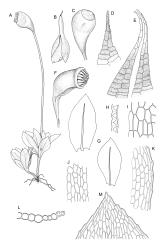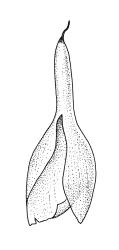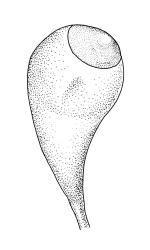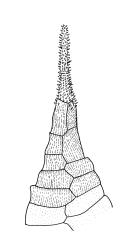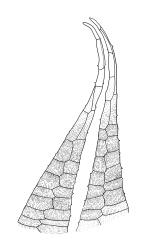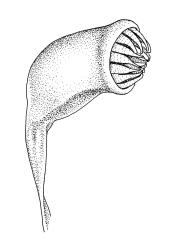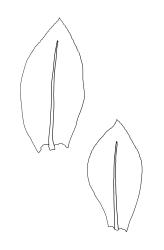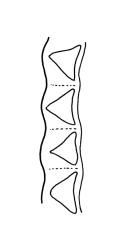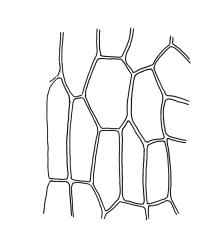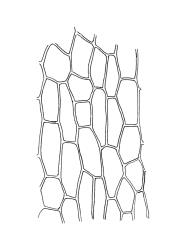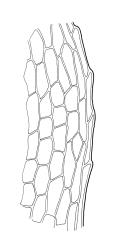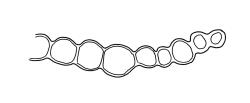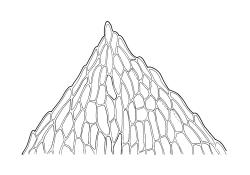- ≡ Weissia radians Hedw., Sp. Musc. Frond. 73 (1801)
- ≡ Bryum radians (Hedw.) P.Beauv., Prodr. Aethéogam. 49 (1805)
- ≡ Eremodon radians (Hedw.) Brid., Bryol. Univ. 1, 236 (1826)
- ≡ Funaria radians (Hedw.) Müll.Hal., Linnaea 18: 692 (1845)
- ≡ Funaria crispula Hook.f. & Wilson in Wilson, Bot. Antarct. Voy. III. (Fl. Tasman.) Part II, 198 (1859) nom. superfl.
- = Funaria acaulis Hampe, Linnaea 30: 624 (1860)
- ≡ Entosthodon acaulis (Hampe) Fife, J. Hattori Bot. Lab. 58: 192 (1985) – as Entosthodon (Plagiodus) acaulis
Plants yellow- or brown-green. Stems red-brown, most 3–5 mm and usually branching once by subperigonial innovation (occasionally elongate to c. 25 mm, but this probably when subject to deposition), beset below with smooth red-brown rhizoids. Leaves erect-spreading, broadly obovate to spathulate, 1.5–3.5(–4.0) mm × 1.0–1.8 mm, ± concave, weakly toothed above, tapered in upper ⅓ to an acute or shortly apiculate apex; upper laminal cells oblong-hexagonal, 45–90(–105) × 30–36 µm, longer and more oblong below; marginal cells longer and firmer-walled to form an indistinct border of 1–3 rows (most obvious at shoulder), often ± yellow, with ends weakly projecting to form short and blunt marginal teeth; apical cell short, 30–90 µm. Costa concolourous or red-brown, c. 45 µm wide near base, failing (5–)7–10 cells below base of the apiculus. Axillary hairs present.
Autoicous. Perigonia and perichaetia as per genus. Setae 5–12(–14) mm, pale- or red-brown, dextrorse, weakly hygroscopic; capsules inclined to nearly horizontal, asymmetric, obovoid, constricted below the mouth when dry, 1.5–2.0(–2.3) mm, with a weakly defined neck c. ⅓ (occasionally –½) the capsule length, red-brown (but often dehiscent when lower portion of capsule is still green), strongly wrinkled below when dry; mouth equal the capsule diameter, ± oblique; exothecial cells with indistinct lumina in surface view, mostly 39–60 µm long and c. 2–4:1, in cross- section with anticlinal walls strongly cuneate, c. 6 rows isodiametric to oblate at mouth; operculum plano-convex. Peristome double; exostome teeth sigmoid, (225–)250–300(–475) × (60–)75–90 µm, acute, vertically striate nearly throughout, coarsely baculate near apices, with marginal appendiculae weak in upper ½ or lacking, with well-developed trabeculae on inner surface, not fused at apices; endostome segments variable, c. 90 µm wide, acute, and c. ¾ height of the exostome teeth or irregular and shorter, striate-baculate below, baculate above. Spores (24–)27–33(–35) µm, insulate-baculate, lacking trilete scars.
Wilson 1859, pl. 175, fig. 2 (as Funaria crispula); Catcheside 1980, fig. 127 (as F. glabra); Fife 1987, figs 1–23 (as E. acaulis).
NI: N Auckland (widespread), including offshore islands (LB, GB), S Auckland, (Moehau, Mercury Bay, near Katikati, Huntly, near Ātiamuri, near Pureora, Te Aroha, near Waimiha), Gisborne (Waiotahi River), Taranaki (Ōmata), Wellington (near Chateau Tongariro, Tawhai Falls, Mangahao Lower Dam, Kaitoke Waterworks); SI: Nelson (Pūponga, Parapara, Little Wanganui, Ōpārara Valley), Marlborough (Pelorus Bridge Scenic Reserve), Otago (Horse Range, Dunedin); A.
Austral-Andean. Tasmania*, mainland Australia*, New Caledonia*, Ecuador*, Venezuela*.
Entosthodon radians occurs mostly on steep clay/silt banks at low elevations. On the North I. it frequently occurs under scrub of Leptospermum scoparium, Sophora microphylla, Geniostoma ligustrifolium, Leucopogon fasciculatus, and Piper excelsum. It is occasionally associated with Drosera auriculata, indicating a tolerance of acidic soils. Associated bryophytes include species of Breutelia, Bryum, Campylopodium, Dicranella, Ditrichum, Fissidens, Philonotis, Polytrichastrum, and Fossombronia. Entosthodon radians is a very common species in N Auckland L.D., but is more scattered south of 38° south latitude. On the North I. ranging from near sea level to at least 1150 m (near Chateau Tongariro, Wellington L.D.) and to c. 210 m (Ōpārara River, Nelson L.D.) on the South I. A single collection made "near the summit of Mt Hauhungatahi," Wellington L.D., from a subnival site at 5000 feet (=1525 m) elevation (J.K. Bartlett s.n., CHR 499633) has also been confirmed.
Degree of endostome development varies within populations and even within single capsules.
The complicated nomenclatural history and typification of E. radians Hedw., including an explanation of why the widely applied Funaria glabra sensu Sainsbury (1955) should not be used for this species, and Funaria crispula Hook.f. & Wilson should be considered a homotypic synonym, was detailed by Fife (1996).
Sainsbury’s (1955, p. 246) report of what he termed Funaria glabra from the Arrow River (Otago L.D.) is based on a misidentification of E. muhlenbergii. The shorter capsule with a weaker neck and the shorter leaf apical cell of E. radians preclude its confusion with the much rarer E. muhlenbergii.




